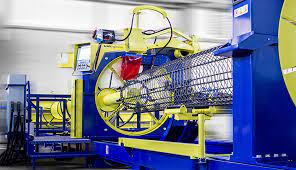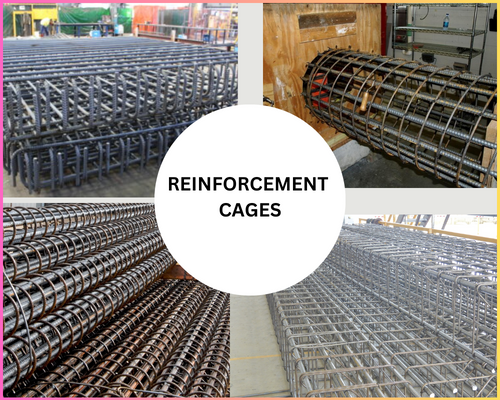Search This Blog
Most Popular
Categories
- Building Construction (87)
- Building Materials (85)
- Columns (2)
- Concrete Beam (3)
- Concrete Construction Techniques (6)
- Concrete Mix Design (14)
- Concrete Repair (14)
- Concrete Slab (11)
- Construction Equipment (17)
- Construction News (7)
- Design of Structures (18)
- Engineering Drawing (1)
- Estimation (3)
- Geotechnical engineering (26)
- Highway Engineering (11)
- Innovations (34)
- Material Testing (11)
- Matrix Analysis of Structures (2)
- Mechanical Engineering (3)
- Strength of Materials (2)
- Structural Analysis (13)
- Structural Design (24)
- Structures (17)
- Transportation Engineering (9)
What are Steel Reinforcement Cages?
Team Prodyogi
October 30, 2023
Steel reinforcement cages are inevitable in the production and manufacture of concrete structures. They are also called rebar cages, or pile reinforcing cages formed either by tying or welding reinforcement as per the layout of the structure. They are commonly used for pile, column, and bridge construction reinforcement.
Reinforcement cages form the skeleton structure for construction. They provide the structure with stiffness, resisting tension, bending, and torque loads. They are fabricated on-site or prefabricated at the workshop based on the required dimensions.
Let's discuss in detail reinforcing cage designs and other features used in concrete construction.
Reinforcement Cage Material
Reinforcing cages can be made of heavyweight and lightweight material. This is decided based on the reinforcement rod diameters and their layout.
Reinforcing Cage Designs
Pre-welded reinforcement cages are more precise in terms of quality and durability. Given the fact, that these cages are now majority supplied in piles, pads, columns, and other shapes based on the design specifications. Based on this, the layout of the cage can be mesh, spatial-square, triangular, T-shaped, or spherical.
A spatial reinforcing cage is obtained by combining several flat frameworks. This way the cost for the complicated cage transportation.
 |
| Pile Reinforcement Cage Welding Machine |
Choosing the Right Material for Reinforcement Cages
Heavyweight Materials
Reinforcement cages can be fabricated from heavyweight materials such as steel bars, often used in applications where high strength and durability are paramount, such as in the construction of bridges, high-rise buildings, and industrial structures.
Lightweight Materials
Alternatively, reinforcement cages can be made using lightweight materials like fiberglass or composite rods. These materials are chosen for specific applications where weight reduction is essential, like in lightweight and precast concrete elements.
Corrosion Resistance
When selecting materials for reinforcement cages, it's crucial to consider their resistance to corrosion. Stainless steel and epoxy-coated steel are often used in environments where exposure to moisture and chemicals is a concern.
Diameter Considerations
The choice between heavyweight and lightweight materials is influenced by the diameter of the reinforcement rods. Heavier materials are typically used for larger-diameter rods, which provide greater structural support.
Spacing and Layout
The arrangement of reinforcement rods within the cage is critical for ensuring structural integrity. Engineers carefully design the spacing and layout to distribute load forces evenly throughout the structure.
Environmental Impact
In some cases, the environmental impact of the chosen material may be a factor. Lightweight materials can reduce the carbon footprint of a project due to their lower transportation and production energy requirements.
Cost Efficiency
Material selection also plays a role in cost efficiency. While heavyweight materials may be more expensive, their higher strength can lead to a reduction in the quantity of materials required.
Compliance with Codes and Standards
The choice of reinforcement cage material should align with local building codes and industry standards to ensure the safety and longevity of the structure.Most Visited
Soil Sampling Methods| Undisturbed and Disturbed Samples
November 08, 2023
Boring Methods for Soil Exploration
November 02, 2023
Steel Column Connected to Concrete Masonry Wall
October 11, 2017
What are Infiltration Wells?
April 15, 2024
How to Choose Good Quality Aggregates for Construction?
August 10, 2021
Terzaghi's Equation: Soil Bearing Capacity for Foundations
March 02, 2022
Bleeding of Concrete- Types, Causes, Tests
October 08, 2017
Search This Blog
MUST READ
What is PERT? Objectives, Pros & Cons
September 10, 2017
Terzaghi's Equation: Soil Bearing Capacity for Foundations
March 02, 2022
Contact Form
Footer Menu Widget
Created By SoraTemplates | Distributed By Gooyaabi Templates


0 Comments
Commenting Spam Links Are Against Policies